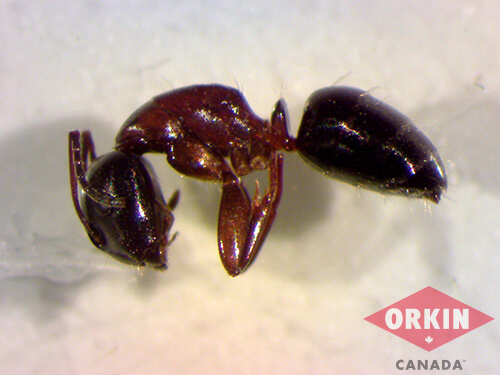How Do Carpenter Ants Get in the Home?
Black carpenter ants are common structure infesting ants found throughout Canada. The tiny insect primarily lives outdoors but gains access to homes when looking for food sources and sites to establish satellite nests. Kitchens and other areas of the house where meals are held serve as common draws to the ant. Carpenter ants enter homes in bathrooms, roofs or basements where leaky pipes and general moisture soften baseboards and other access points so that ants can dig or excavate to invade. They also crawl along and through utility lines, via shrubs or tree branches touching houses. Once indoors, carpenter ants can establish nests in wall voids, attics, insulation, crawlspaces etc. The ants are capable of burrowing through sound wood but prefer softer, water and heat-compromised woods, in both homes and outdoors, to build into or travel through.
Indoor House Damage
The damage caused by carpenter ants usually manifests in the declined structural integrity of joists, trusses, support beams, and the overall foundation of a home. Carpenter ants dig elaborate systems of tunnels into woods within homes and outdoors, which are recognizable by piles of removed saw-dust like debris at tunnel entrances and exits. Homeowners will generally see the large worker ants of carpenter ant colonies first. The large, wingless ants act as scavengers and often report back to their respective colonies about food sources. As such, worker ants seen in the home may not necessarily signal an infestation but rather the possibility of one as sightings clearly indicate viable access points for the species of ant.
Moisture and Wood
The most important key factors that attract carpenter ants in homes and yard are moisture and dead wood. In order to prevent a carpenter ant infestation in homes and on property, residents should inspect and repair water leaks from faulty pipes or roofs. Wood structures compromised with such leaks should be ventilated to dry. If possible eliminate or reduce dead/decaying wood, logs or trees stumps from yards. Trim back shrubs or tree branches that touch the house. In doors, homeowners can prevent the attraction of carpenter ants by cleaning up food spills and putting meals away as soon as possible. Removing excess moisture from the air by proper ventilation also helps detour carpenter ant infestations.
Carpenter Ants in Winter
Like all other insects, the carpenter ant is a cold-blooded animal whose body temperature fluctuates to match the changes in temperature of the surrounding environment. During the winter in Canada, where the season often produces bitterly cold weather, carpenter ants become incapable of maintaining a body temperature high enough to support physical activity. Consequently, the insects hibernate in the nest and remain inactive until the arrival of warmer weather in the spring. Regardless of the placement of the nest, most carpenter ant colonies become dormant in winter, especially when exposed to the outdoor elements. Indoor nesting sites, however, sometimes receive enough heat for carpenter ants to forage actively throughout the year.
For indoor colonies to remain active during the winter, the nest must occupy a site within close proximity to a heat source. Wall voids directly in the path of sunlight or heated air from a furnace often provide the warmth needed to stimulate the activity of carpenter ants. When carpenter ants inhabit heated indoor areas during winter, the insects typically wait until the nighttime hours to come out and search for sources of moisture in places like bathtubs, dishwashers, sinks, and toilets. However, on particularly sunny days, carpenter ants may emerge from the nest and explore other parts of the home. During the winter months, the presence of carpenter ants actively moving around in the house is a clear indicator of an indoor infestation.
To control an active infestation, contact a licensed pest control professionals, who will use most effective and appropriate treatment strategies to control the infestation. In cases of extreme infestations and structural damage, homeowners should consider replacing damaged baseboards, floorboards, struts, studs, and joists due to the compromised strength of the woods after carpenter ants have successfully been treated and controlled. Replacing affected wood may also limit access points for future infestations.

You may also like
Top Pests Expected To Trend In The Summer Of 2023
Warm weather is around the corner, which means pests that have been overwintering or hibernating will wake up as well as non-hibernating pests will start making an appearance outdoors. Being prepared for those spring and summer pests can have an impact on how enjoyable your time will be at home or at work. Using industry leading expertise, we have put together a comprehensive list on the top 8 pests expected to trend in the summer of 2023. This list will provide a deeper dive into the impact that pests can have on your property, along with prevention tips to keep your home or business pest-free.
Top 4 Tips For A Pest-Free Halloween
You may have been tricked by the plastic bats and fake spider webs in your neighbourhood, but the pests trying to make your house their home can be the scariest trick during Halloween. From rodents trying to trick or treat inside your home to flies trying to enjoy your jack-o’-lanterns, pests are always looking for ways to get into the Halloween spirit (and your home). Don’t worry, you’re not alone in trying to pest proof your home, as your Orkin Canada Pro has put together a list of 4 quick tips that will help you keep pests out this Halloween.
4 Easy Tips To Pest Proof Your Garden
Spring is the perfect time to get the garden tools out and start getting the garden box ready to grow some vegetables and your favourite flowers. You might do this every year, or this is your first attempt at gardening, regardless of your experience level, we're here to help you keep pests out. Our experienced Ph.d. entomologist Alice Sinia has put together a few easy and simple tips keep your garden pest free.
Practical Ways To Prevent Warm Weather Pests
Spring has arrived, and the pests are already starting to make their usual rounds. As they seek food, water and shelter, your home is like a bug and rodent oasis just waiting to be occupied. But nobody likes surprise invaders in their living space, which is why it’s crucial to recognize the most common threats and take action to prevent them.
Remove pests from your home, and stop them from coming back
We work hard to listen, understand and assess your unique situation. Request a free, no-obligation estimate today for a customized pest program that fits your needs.
Request a Free Home EstimateRequest a Free Business Consultation

